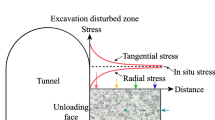Abstract
This paper presents a new Acoustic Emission (AE) source location method in combination with a Wigner-Ville Distribution (WVD) and a theoretical velocity dispersion model in dispersive rock. This method does not require measuring the first arrival time of a signal, and is able to provide reliable and identical Time-of-Arrival-Differences (TOADs) regardless of the frequency components in the obtained signals. The basic idea behind this is that, if at least two dominant frequency components in the output signals can be determined from the WVD analysis of the test results, a full wave dispersion curve of the arriving signal is obtained in accordance with the theoretical wave model, where the time differences between dispersion curves are identical through the entire effective frequency range of the AE transducers. Biot’s model was applied as a velocity dispersion model, and the smoothed pseudo WVD was used to reduce the cross-term interference. It was found that the frequency-dependent arrival time traveling with the group velocity was easily determined with the help of the theoretical model, and the source location results based on the WVD algorithm and theoretical model agree better with the true locations than those from the Time-of-First-Arrival Differences (TOFADs).
Similar content being viewed by others
References
ASNT (1987). Nondestructive testing handbook: Acoustic emission testing, Amer Society for Nondestructive, 2nd Ed., Vol. 5.
Bin, G. F., Liao, C. J., and Li, X. J. (2011). “The method of fault feature extraction from acoustic emission signals using Wigner-Ville distribution.” Advanced Materials Research, Vol. 216, pp. 732–737.
Biot, M. A. (1956a). “Theory of propagation of elastic waves in a fluidsaturated porous solid: I. Low frequency range.” Journal of the Acoustical Society of America, Vol. 28, No. 2, pp. 168–178.
Biot, M. A. (1956b). “Theory of propagation of elastic waves in a fluidsaturated porous solid: II. High frequency range.” Journal of the Acoustical Society of America, Vol. 28, No. 2, pp. 179–191.
Ciampa, F. and Meo, M. (2010). “A new algorithm for acoustic emission localization and flexural group velocity determination in anisotropic structures.” Composites Part A: Applied Science and Manufacturing, Vol. 41, No. 12, pp. 1777–1786.
Grosse, C. U. and Ohtsu, M. (2008). Acoustic emission testing, Springer.
Hardy, H. R. (1994). “Geotechnical field applications of AE/MS techniques at the Pennsylvania state university: A historical review.” NDT&E International, Vol. 27, No. 4, pp. 191–200.
Jeong, H. and Jang, Y. S. (2000). “Fracture source location in thin plates using the wavelet transform of dispersive waves.” IEEE Trans Ultras Ferroelectr Freq Control, Vol. 47, No. 3, pp. 612–619.
KAERI (2009). High-level radwaste long-term management technology development (V): In-situ study on the Performance of Engineered Barriers, KAERI/RR-3120/2009, Daejeon, Korea.
Keller, J. D. (1989). “Acoustic wave propagation in composite fluidsaturated media.” Geophysics, Vol. 54, No. 12, pp. 1554–1563.
Koponen, A., Kataja, M., and Timonen, J. (1996). “Tortuous flow in porous media.” Phys. Rev. E., Vol. 54, No. 1, pp. 406–410.
Li, Y. and Zheng, X. (2007). “Wigner-Ville distribution and its application in seismic attenuation estimation.” Journal of Applied Geophysics, Vol. 4, No. 4, pp. 245–254.
Mavko, G., Mukerji, T., and Dvorkin, J. (1998). The rock physics handbook: Tools for seismic analysis in porous media, Cambridge University Press, Cambridge.
Oh, T. M., Kwon, T. H., and Cho, G. C. (2011). “Effect of partial water saturation on attenuation characteristics of low porosity rocks.” Rock Mechanics and Rock Engineering, Vol. 44, No. 2, pp. 245–251.
Ohtsu, M., Yuyama, S., and Imanaka, T. (1987). “Theoretical treatment of acoustic emission sources in microfracturing due to disbanding.” Journal of the Acoustical Society of America, Vol. 82, No. 2, pp. 506–512.
Olma, B. J. (1985). “Source location and mass estimation in loose parts monitoring of LWR’s.” Progress Nuclear Energy, Vol. 15, pp. 583–593.
Park, S., Anton, S. R., Kim, J. K., Inman, D. J., and Ha, D. S. (2010). “Instantaneous baseline structural damage detection using a miniaturized piezoelectric guided waves system.” KSCE Journal of Civil Engineering, KSCE, Vol. 14, No. 6, pp. 889–895.
Park, J. H. and Kim, Y. H. (2006). “Impact source localization on an elastic plate in a noisy environment.” Measurement Science and Technology, Vol. 17, No. 10, pp. 2757–2766.
Santamarina, J. C., Klein, K. A., and Fam, M. A. (2001), Soils and waves, Wiley, New York.
SKB (2005). ASPO Pillar stability experiment: Acoustic emission and ultrasonic monitoring, SKB Report R-05-09, Sweden.
SKB (2007). Aspo hard rock laboratory: Aspo pillar satability experiment, Final Report, SKB TR-07-01, Sweden.
Stoll, R. D. (1980). “Theoretical aspects of sound tranmission in sediments.” Journal of the Acoustical Society of America, Vol. 68, No. 5 pp. 1341–1350.
Tsunoda, T., Kato T., Hirata, K., Sekido, Y., Sendai, K., Segawa, M., Yamatoku, S., Morioka, T., Sano, K., and Tsuneoka, O. (1985). “Studies on the loose part evaluation technique.” Progress Nuclear Energy, Vol. 15, pp. 569–576.
Turgut, A. and Yamamoto, T. (1990). “Measurement of acoustic wave velocities and attenuation in marine sediments.” Journal of the Acoustical Society of America, Vol. 87, No. 6, pp. 2376–2383.
Ville, J. (1948). “Théorie et applications de la notion de signal analytique.” Cables et Transmissions, Vol. 2A, No. 1, pp. 61–74.
Wigner, E. (1932). “On the quantum correction for thermodynamic equilibrium.” Physical Review, Vol. 40, No. 5, pp. 749–759.
Wu, X. and Liu, T. (2009). “Spectral decomposition of seismic data with reassigned smoothed pseudo Wigner-Ville distribution.” Journal of Applied Geophysics, Vol. 68, No. 3, pp. 386–393.
Yaghin, M. A. L. and Koohdaragh, M. (2011). “Examining the function of Wavelet Packet Transform (WPT) and Continues Wavelet Transform (CWT) in recognizing the crack specification.” KSCE Journal of Civil Engineering, KSCE, Vol. 15, No. 3, pp. 497–506.
Author information
Authors and Affiliations
Corresponding author
Rights and permissions
About this article
Cite this article
Kim, JS., Choi, YC., Choi, JW. et al. A combined method of Wigner-Ville distribution with a theoretical model for acoustic emission source location in a dispersive media. KSCE J Civ Eng 17, 1284–1292 (2013). https://doi.org/10.1007/s12205-013-0418-6
Received:
Revised:
Accepted:
Published:
Issue Date:
DOI: https://doi.org/10.1007/s12205-013-0418-6




